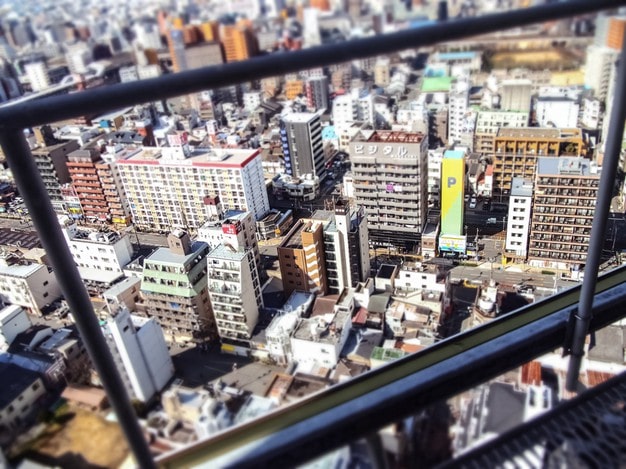
You Wish You Had Read This Guide Before
While a camera is different from the human eye, when it comes to perspective, what a traditional lens captures is quite close to what the human eye sees. But, if we add a tilt shift lens to the camera there are many possibilities to alter that perspective and achieve a “miniature” effect.
So what exactly is a tilt shift lens and what is it for? In this article we will tell you about the best uses and we will share everything you need to know about this incredible photography lens.
1. What Is the Best Lens for Architectural Photography?
If you want to do architectural photography and you want your photos to make a difference, tilt shift lenses will be your best allies. They bring many advantages, since they allow you to straighten the lines when you take the photograph.
However, these lenses are more expensive and intended for professionals, but it is an alternative that can save you a considerable amount of time and improve the quality of your photos.
2. What Is Tilt Shift?

The main feature of a tilt shift lens is that the inner optics can be tilted and shifted relative to the camera sensor. Newer lenses also rotate, allowing it to tilt and move in different directions.
These lenses are manufactured with perspective correction in mind and help maximize or minimize depth of field in photography. Tilt shift lenses are made up of 3 sections that allow you to tilt and move the optics. This offers two main benefits:
- The ability to change the angle of the axis of the focus plane and influence the depth of field without changing the aperture of the diaphragm
- The ability to change perspective without having to change the parallelism between the lens and the photographed subject
Among those who have not used it ( yet ), there is a certain mystery and taboo surrounding the tilt shift lens. It may be that this is the least known lens among DSLR lenses. It is also true that when using this lens, many people do not take advantage of its capacity and characteristics 100%. The main reason is that compared to normal lenses, the tilt shift lens is very different from the rest.
It should also be noted that some tilt shift lens models allow the tilt and shift orientation to be set independently, greatly increasing the flexibility of this type of lens. The tilt shift is a widely used resource for making time lapse videos.
Tilt Shift Lens Features
Knobs and Buttons
The first thing we can notice in the tilt shift lenses is the presence of 4 knobs and at least one rotation button. Two of them are used to maintain the tilt and shift of the lens, while the other two knobs are used to regulate the angle of movement ( tilt and shift ).
Tilt

The tilt function makes the plane of the lens and the image sensor not parallel. This may seem very complicated, but this function can change your focus plane to a great extent.
In a typical photography lens, the plane of focus and the plane of the sensor are parallel. What does this mean? That if you focus on an object 180 meters away, all objects that are 180 meters away will also be in focus.
If you tilt the lens to the left or right, you will change the way the two planes interact as the plane of focus passes vertically through the frame. This means that everything from the front to the back of the frame will be in sharp focus.
When using a relatively wide aperture, the areas to the left and right of the image will gradually blur.
Shift
Compared to the image sensor, the shift function of the lens causes the lens’ optical system to move. These lenses are designed to project a larger image circle than typical lenses. By moving the lens, you can photograph your subject from different camera positions. This feature allows you to photograph buildings without converging verticals.
To do this, the camera must be positioned horizontally and pointed directly at the building. Next, you need to move the camera up to include the top of the building.
3. How to Use a Tilt Shift Lens?
All tilt shift lenses are manual focus, but this function can only work when the focal plane is parallel to the sensor plane. The advantage of these lenses is that when you tilt or shift it, you can see how the lens will move, allowing you to immediately preview the effect you will achieve.
Shift
On the tilt shift lens, there are two adjustable knobs on the left and right sides, which allow you to move the lens to either side. Moving the lens to the left will move your focal point to the right. This sounds counterintuitive, but it is because the area is now closer to the sensor plane.
By placing your focal point on the right, everything on the left will lose focus. This technique is very useful when the object or area we want to focus on is to the right and away from the camera and vice versa. Moving the lens to the right will place the focus point on the left side of the frame.
With the shift option, you have up to 12mm to shift. The best part is that you can achieve a great depth of field with a fairly wide aperture, like f / 2.4.
Tilt
To tilt the lens, you have to use the two knobs that are on the top and bottom of the lens. If you tilt the lens, it will give the impression that the camera is positioned much higher.
If you are at the bottom of a building, you must tilt the lens up to correct for converging vertical lines. If you are on top of a building or structure and you want to shoot a photo, you need to tilt the lens down.